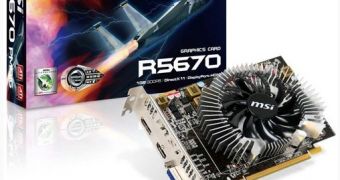Like all other manufacturers of Advanced Micro Devices-based hardware, Micro-Star International (MSI) has launched its own version of the Radeon HD 5670 graphics adapter. Developed by AMD and based on the Redwood graphics processing unit (GPU), the HD 5670 aims to become the mainstream choice of end-users seeking DirectX 11 performance. While MSI's R5670-PMD1G possesses standard technical specifications, it has a range of special features that enhance its stability and overclocking potential.
“With ATi RadeonTM HD 5670 standard technical specifications, including DirectX 11 and ATi Eyefinity technology, MSI R5670-PMD1G adopts unique designs, like GPU voltage adjustment, next-generation DisplayPort output and military class components. Hence, MSI R5670-PMD1G can fine-tune its performance and have better extensibility so that it is mainstream players’ best choice for high C/P value,” the press release said.
The R5670-PMD1G features 1GB of GDDR5 memory and, besides DirectX 11 capabilities, it supports the ATI EyeFinity technology and has unique designs, such as military class components, a DisplayPort output and GPU voltage adjustment. In addition, MSI's exclusive Afterburner overclocking tool can even manipulate not only the GPU and memory clocks, but also modify the voltage in order to enable a higher performance potential.
Of course, overclocking always brings risks, and MSI built its product with the aforementioned military class components in order to increase its stability. The graphics card employs the All Solid Capacitor and All Solid-State Choke, which extend the lifespan and avoid the high frequency noise generating from choke vibration under high loading. In addition, the power stability is assured, even under overclocking or full-load conditions, by the Hi-c CAP, Tantalum capacitor.
Unfortunately, the Redwood-based MSI R5670-PMD1G graphics card is not yet available, but is listed for pre-order, with a price tag of 99 Euro. At such a price, it will likely become one of the more prominent choices in mainstream end-users' system configurations.

 14 DAY TRIAL //
14 DAY TRIAL //